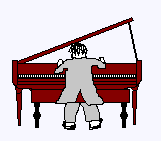Using music with your Video
 |
About Music in Video Generally
Music has become one of the most important elements in video and film. Music and content have related to each other since the creation of opera late in the 16th century and melodrama -- literally music (mélo, from the Greek) with drama -- in the 19th century. More recently, commercial video has associated light, bouncy music with sit-coms, game shows and talk shows, and heavy, ominous music with dramas, science fiction and horror shows and serious documentaries. This association is so pervasive that we don't even have to watch the screen to know what kind of show is on. |
-
M/TV has conditioned our ears and eyes to expect music and visual image to relate to each other in another way. Pictures change with the beat of the music.
In the simple 1-2-3, 1-2-3 beat of the waltz, for example, the cut from one picture to the next would probably come on the accented first note of a measure:
| OOM pa pa, | OOM pa pa, | OOM pa pa, |
| (cut) | (cut) | (cut) |
Of course, the cut could come on one of the "pa" notes, which would create a much more subtle relationship between music and video than the more obvious cut on the accented "OOM" note. With "beat edits" there are no rules -- only the convention that the cut comes on a beat of the music.
Watch some M/TV and commercials. See if you can hear and see this relationship between the visual and the aural.
- Music for Your Special Video
 |
How you want to deal with music in your video will determine at what stage of the editing process you add music to the piece. |
-
If you want to edit on the beat -- beat editing, this is called -- we record your audio first. Then the video segments are added. You will be able to hear the music as you edit, so you can tell exactly where each cut or dissolve should come.
Beat edits create a certain structure to your piece. The occurrence of the beats in the music more or less dictates the length of each video segment, although, using the "OOM pa pa" illustration above, you could edit on each "OOM", or on the first and second, the first and third, etc., to control the length of your edit segments.
| Beat edits: | music recorded first |
| Music as general background: | music after video is finished |
Last modified 3/16/2020
Designed for VideOccasions by Jack Wolcott

